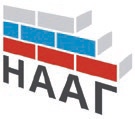News & Markets
5th NAAG conference for Russian autoclaved aerated concrete manufacturers
Still good demand for autoclaved aerated concrete in Russia
Loading...Whereas producers of large-format bricks and sandlime bricks had to cut back their production volumes in 2018 by 29% and 54% respectively in comparison with 2014, autoclaved aerated concrete manufacturers only produced just 10% less in 2018 than in 2014. Based on its members’ quarterly results already available up to the conference, the Russian “National Association of Autoclaved Aerated Concrete Manufacturers” (Natsionalnaya assotsiatsiya proisvoditeley avtoklavnogo gasobetona, NAAG) forecast a production volume of 12.40 million m3 for 2019 signifying a return to the 2014 level.
A shift in wall construction material usage away from bricks and lime-sand bricks to autoclaved aerated concrete blocks also played into the hands of their manufacturers. Strongest growth was registered in the south of Russia and the Caucasus region.
These trends in development were one good reason for selecting the southern Russian town of Pyatigorsk as venue for the “Fifth international scientific- practical conference on ‘Modern autoclaved aerated concrete’”, which was held there from 16 to 18 October. Gleb Grinfeld, NAAG executive director, gave a warm welcome to just over 200 specialists, all representatives of autoclaved aerated concrete production facilities, supply companies, universities and research institutes along with the trade press. The auditoriums and entrance hall, where representatives of Aircrete Europe, Hess AAC Systems, Keda Suremaker, Masa, WKB Systems, Zauralskaya kompaniya and Wehrhahn talked and fielded questions, were very well filled on every day of the conference.
From production optimisation to new markets
The two plenary sessions of the event’s lecture programme on the two first days were subdivided into “The current situation in the production and application of autoclaved aerated concrete” and “Development prospects for the autoclaved aerated concrete sector” as well as into four sessions with the subjects “Optimising autoclaved aerated concrete production”, “Utilising autoclaved aerated concrete”, “Technology and quality” and “Systems engineering”.
The discourses on new markets, e.g. for decorative elements made from autoclaved aerated concrete that can be applied to façades to replace bricks, attracted a great deal of interest. These differently coloured elements represent an outstanding, yet substantially less expensive, alternative to bricks for building contractors and a potential new market segment for autoclaved aerated concrete manufacturers
Alongside this niche application, exporting autoclaved aerated concrete products beyond the borders of the Russian Federation has now become a realistic possibility for growth. Just recently, a Russian autoclaved aerated concrete production facility, equipped with the necessary certificates and CE marking, was able to supply a construction site in Great Britain – also an opportunity for other Russian manufacturers.
Moderators and participants in the conference engaged in a vigorous debate about the introduction of autoclaved aerated concrete blocks with lower bulk density on the market. Although some manufacturers are forging ahead and have already launched socalled D-300 blocks (bulk density 300 kg/m3) on the market, others doubt whether customers are ready for such products.
The good organisation and moderation at each individual session coupled with the willingness of the organisers to experiment with new communication channels (including a Skype link to Great Britain) facilitated a lively exchange in the open discussion rounds from the various conference participants.
Factory visit to DSK Gras-Svetlograd
Alongside the Gala Dinner – a must on the event’s second evening – and a tour of the town of Pyatigorsk, the supporting programme included a visit to the DSK Gras-Svetlograd autoclaved aerated concrete production facility in the city of Svetlograd about 180 km north of the conference location. DSK Gras-Svetlograd and another autoclaved aerated concrete factory belong to the ZAO MPRK Gras concern with its headquarters in the capital, Moscow (see AAC 01/2020, page 68). At its site in Svetlograd, DSK Gras-Svetlograd mainly manufactures autoclaved aerated concrete blocks for residential and commercial construction work.

Natsionalnaya assotsiatsiya
proisvoditeley avtoklavnogo gasobetona (NAAG)
Udelny prospekt, d. 5, liter A, pom. 38-H, of. 7
194017 St. Petersburg, Russia
T +7 904 634 3888
as@gazo-beton.org
www.gazo-beton.org